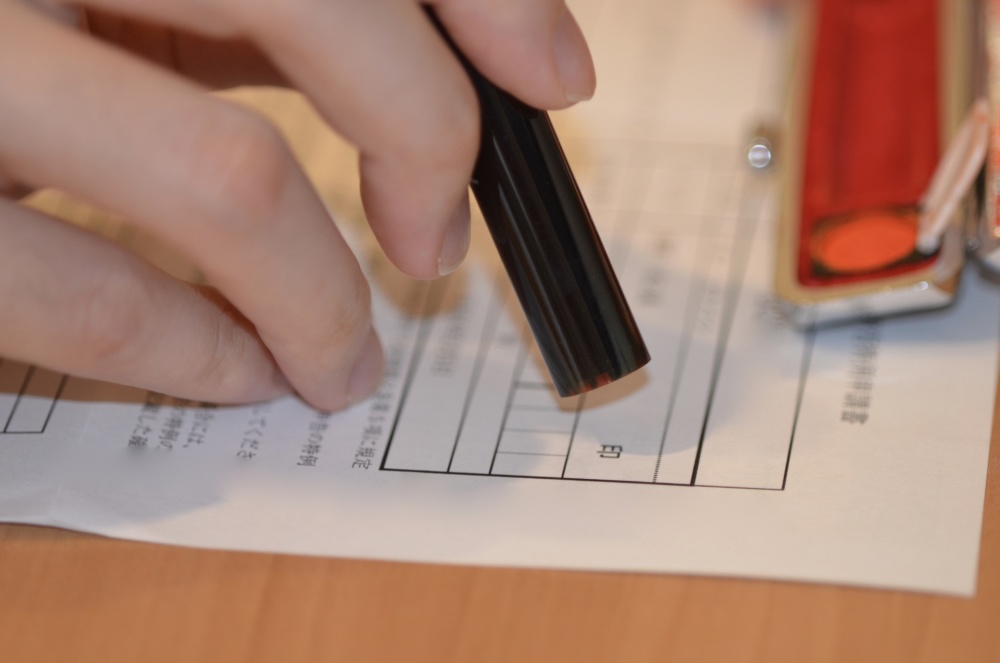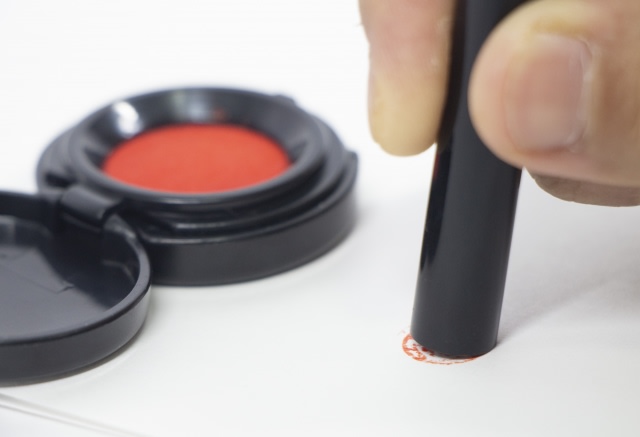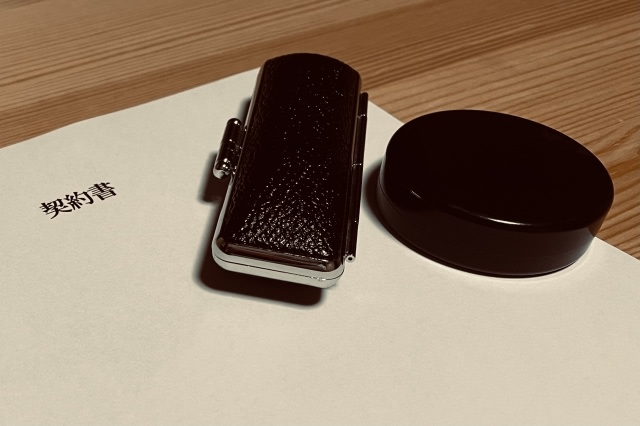Updated August 27, 2024
The Hanko Stamp: A Guide for Foreigners in Japan
Japan may have a history of technological prowess, but some traditional practices still persist in everyday life.
One such practice that may surprise foreigners living in Japan is the use of "hanko" stamps. If you haven’t been introduced yet, a hanko, also known as an inkan, is a carved, personalized stamp that you use as a signature when signing official documents.
So, does everyone need a Hanko stamp? If so, how do you get one made? Are there different Hanko stamps for foreigners?
In this crash course on Hanko (inkan) stamps, I’ll answer these questions and discuss whether Inkan stamps are becoming obsolete in today’s digitized Japan.
First, let’s take a closer look at the stamp itself.
What Is a Hanko Stamp?
Essentially, a Hanko (はんこ) is a carved stamp that has your last name on it in kanji characters. Inkan (印鑑), which is used interchangeably with Hanko, is actually the name of the mark or the signature the stamp leaves behind.
The stamp is usually no bigger than 2cm in diameter and comes in round, oval, and square shapes. So, it’s very small, fits in the palm of your hand easily, and comes in a stick-like container that resembles a thick lipstick.
When the carving is pressed on a piece of paper, the Hanko stamp leaves the owner’s last name in red ink, which is the color of most inkan stamps. However, the red color of the ink isn’t a rule, and you might see ones with different colored ink too.
Hanko stamps are used in various ways in daily life. For example, you can use it to sign when receiving a package you ordered or sign your banking papers and other documents.
The tradition of stamping one’s name as a way to sign or “officiate” documents actually dates back to the 8th century. While the use of the stamp began with the emperor, it quickly spread among the upper class and was even adopted by samurai in Feudal Japan.
Since the Meiji period, Hanko stamps have been used by the general public, and every person got one. Today, while being slowly phased out as I’ll explain in a bit, Hanko stamps are still in use and almost all adults have one.
With our introduction and brief history lesson out of the way, it’s time to talk about the different types of Hanko seals that are in use today.
Types of Hanko: For Personal or Corporate Use Cases
Perhaps the first difference you should know about these seals is that they come in many forms. Some are for personal use cases, while others are reserved for corporations. Some must be registered, while others can be used unregistered. Let’s explore this in more detail.
Registered vs Unregistered Hanko: What’s The Difference?
As I said, there are many different types of hanko in Japan that are used for different purposes. Unregistered stamps are used for informal situations, whereas registered stamps are used for formal situations when signing official and other important documents.
For instance, the most commonly used everyday stamps, Mitomein and Sanmonban, aren’t required to be registered, but the seal you’ll use at the bank definitely does.
Your seal will be registered at the bank when you open your account, and the stamp used for government-related procedures is registered at your local government office or city hall.
Keep in mind that in order to have a seal registered, you need to be able to present it, so keep it on yourself. Most city halls have automated this registration system, so you may even be able to handle this after hours or during national holidays.
Hanko Types for Personal Use
As you may have guessed, personal hankos are essentially for personal use. A personal seal acts as the person’s signature or even a passkey at the bank.
The rules around personal seals are a little more relaxed compared to corporate-use ones. So, you may see a bit more variation in terms of shapes and sizes.
Personal hankos are for everyday use and for handling official government business.
However, depending on where you use it, there are a few more distinct types of personal seals as well. Let’s begin with the one you’ll use the most often.
Mitomein (認印)
A Mitomein is a personal stamp for informal use. Its most common use is to accept or acknowledge things, such as neighborhood notices. This is the stamp you’ll use the most often, and it’ll come in handy in many instances in your daily life.
For instance, I mentioned that you could use your Hanko seal to receive packages. Mitomein is the one you want to use for this. Similarly, when you need to read a paper before you sign it, this stamp can be used to simply show that you read and understood the document's contents.
Because of its less formal use cases, a Mitomein does not have to be registered at your local ward office or city hall.
As all family members use one Mitomein in most cases, the stamp only includes the last name of the user, but this can also be a nickname you’re rather known for, as it’s an unofficial seal.

Jitsuin (実印)
A Jitsuin is your personal seal for handling matters at your local government office, city hall, and other government-related matters. It’s the most formal type of seal – your officially registered Hanko.
In this context, registered means that you have to get your seal approved and registered at your local city hall or ward office. “Local” is important here, as you have to get your seal registered in a city hall that has jurisdiction over your place of residence.
Another rule specific to Jitsuin seals is that they need to fit in an 8mm to 25mm square. That said, your seal can be oval, round, or square as long as it fits within the designated area.
You can also choose to have a seal with only your last name registered, in addition to your full legal name or legal aliases you may have. That said, you can only have one Jitsuin registered for yourself, as each person only gets to have one.
As this is arguably the most important seal type, Jitsuin seals are usually made with high-quality, durable materials. After all, you use this seal to take on serious undertakings or enter into a serious contract, such as a house loan.
Ginkōin (銀行印)
The special seal used for banking purposes is known as Ginkōin.
This seal is registered with the bank when you open your bank account, and they simply copy the imprint the seal leaves behind to identify whether it’s really you.
This stamp needs to include your name or initials clearly, and it must look distinct from other seals so it doesn’t get mixed up.
As for the size, once again, the Ginkōin needs to be clear and distinct, so nothing too small. Something that’s about 14-15mm in diameter should be fine.
As the seal is registered at the bank, you can use it to authorize your banking tasks, withdraw money from your account, or set up automatic charges from your account for your monthly utility bills.
Don’t forget that you’ll need this seal to withdraw large amounts of cash or close your bank account. So, always bring your Ginkōin with you to the bank just in case.
Sanmonban (三文判)
A Sanmonban is another informal type of personal stamp and is similar to Mitomein in many ways.
However, the biggest difference that sets it apart is that these are even more casual and are made of cheap materials, such as plastic. Sanmonban seals also have their own ink, which is usually built into the case that the stamp is enclosed in. This way, you don’t have to use an inkpad and can stamp on the go.
For reference, the ink Sanmonban seals include is called Shachihata (シャチハタ). This is important because you may occasionally see warnings not to use Shachihata on certain documents, in which case you should use your Mitomein instead.
Hanko Types for Corporate Use
As a resident, learning the personal stamps I introduced above is just fine. However, in order to be thorough, we should also mention the Hanko types reserved for corporate use cases.
As you may have guessed, the stamps I’ll introduce below are owned by a legal entity, such as a corporation or a small business.
Kaisha Jitsuin (会社実印)
Similar to a personal Jitsuin seal, the Kaisha Jitsuin is the government-registered seal of a corporation or other legal entity.
This seal is registered when you open your business, and representatives can use it to authorize things on the company’s behalf. As it’s a registered seal, it can be used for all official matters related to the business.
As Kaisha Jitsuin is used by the company’s official representatives, the seal should include both the representative’s name and the company's name.
Kaisha Ginkōin (会社銀行印)
While the regular Ginkōin is used for personal banking matters, Kaisha Ginkōin is the banking stamp of a corporation.
It has a specific look, with the bank’s logo in the center and the company name engraved around it.
This seal is used for all finance-related matters, like cashing or exchanging checks, making payments on behalf of the business, etc.
Kaisha Kakuin (会社角印)
Unlike the other two round-shaped seals, the Kaisha Kakuin seal is a square seal. It’s also for corporate use, but it’s mostly used for internal documents and processes and for approving business-related invoices and receipts.
Within the square shape, usually only the company name is engraved. As you can guess, this is a less formal seal than the Kaisha Jitsuin seal and is used for smaller business-related matters in general.
How Are Hanko Stamps Used in Japan?

With all the Hanko types out of the way, let’s talk about whether you really need a Hanko seal in Japan today.
First, let’s mention some of the use cases of the Hanko seal today:
Signing contracts
Registering for or applying for a job
Handling official matters at your local city or ward office
Signing any other document or matter that may need personal, official authorization
At first glance, Hanko stamps seem to be multi-functional and even crucial in daily life in Japan. However, hanko seals are mostly used as a form of signature and are becoming somewhat obsolete, especially since the pandemic.
Abolishing Hanko: Is Hanko Necessary In Japan Today?
The necessity of hanko seals is a big point of discussion in Japan.
Ever since the pandemic, when people couldn’t leave their houses, the use of physical hanko seals has become a big roadblock to the digitalization of all government and business matters.
During this time, people often had to go to the office just to stamp one document, which revealed that the use of mandatory physical stamps wasn’t feasible in today’s world.
As a response to this, in late 2020, Japan’s Minister of Administrative Reform Taro Kono announced the government’s plans to abolish the use of personal seals completely.
The government’s promises mostly paid off, and today, only about 80 out of 14,000 types of official government documents require an inkan seal to be official.
What’s more, the private sector also followed suit. The number of companies switching to electronic signatures, such as Docusign and Cloudsign, has been on a steady increase in the past years. So, it’s safe to say that most businesses in Japan have moved on from Hanko seals today.
So, if the seals are slowly being phased out of daily use, should you, as a foreign resident of Japan, still get one? Let’s talk about it.
So, Do You Need A Hanko As a Foreigner?
As a new resident of Japan, not having one isn’t a significant issue.
In most cases where you’re required to seal a document, you might just say you don’t have one, and they’ll let you use your regular signature instead, as you’re a foreigner. Unless a specific government procedure calls for it, which, as I mentioned, there aren’t too many left, you can get away with just signing things most of the time.
Still, having your personal hanko seal can make you feel much more integrated into Japan and will save you from the dreaded “but I’m a foreigner…” conversation, too. Also, bigger cities in Japan might be more accustomed to handling foreigners without a hanko, but that’s not always the case for smaller cities in the countryside. I recommend getting one as it might prove useful and save you valuable time in some situations.
Having a Hanko Seal Made: How To Get Hanko in Japan
If you’ve decided to get a Hanko seal made as a foreign resident of Japan, you probably want to know how one goes about getting one made.
The process used to be mostly an in-person experience, and you’d go to your local Hankoya, which are local hanko shops, to get one made. However, today, local Hankoya stores are mostly replaced by big store chains.
Besides, getting a Hanko in 2024 is pretty much a digital experience. Unless you personally want to go to a store to get one for the experience of it all, there’s no reason for you to leave your house to get a Hanko made today.
I’ll share some of the best places you can get a Hanko made, but whether you do it online or in person, you should first pick the name that’ll be carved into your personalized seal.
Choosing Your Name
When it comes to choosing your name, you have a few options.
First of all, it’s possible to get a hanko with your name in alphabet letters. So, you don’t necessarily have to have a name in Kanji. That said, it certainly helps to have a name in Kanji if you plan on settling down in Japan.
You can have your name on your hanko seal carved in katakana, hiragana, or kanji. There’s essentially no rule regarding one or the other, but the word length is what’s important here.
The Hanko seals are very small, so either your first or last name will fit.
Another point to consider when choosing your name can be its distinctiveness in kanji, for instance. You can decide what looks good on your seal yourself. In fact, some people directly translate their names to kanji using online tools like Kanji.Tools and Kanji Hanko, both popular name generators worth giving a try.
Picking The Material and The Unethical Side of Hanko Production
After you decide on a name, all you need to do is get your seal made. Hanko seals are made from many different materials, and the prices change accordingly. Some people even get titanium or gold ones, but you can also pick more interesting materials, such as rock.
One important point to be made here is that the use of elephant ivory is unethical and should be avoided.
Unfortunately, before public awareness was raised regarding the cruelty associated with the practice of harvesting ivory from elephants, it was a common practice to use the material for hanko seals. Some even call this “traditional.”
However, it should be noted that this practice is banned by the Convention on International Trade in Endangered Species of Wild Fauna and Flora. Despite this, some shops unfortunately still take pride in offering ivory hanko seals and are therefore best boycotted.
When picking a material, you have many nicer options anyway. Consider wooden ones for affordably priced seals, or if you want something fancier, go for silver or even crystal. The cruelty-free possibilities are endless!
Ordering and Receiving Your Hanko Stamp
Upon picking a material, you’ll need to provide the name you pick exactly as you want it to show up on your inkan.
Deciding on the final design can be tough, but some stores offer to send you a mock-up design before you get the seal made, which can help you choose.
If you’re ordering from an online store, all you need to do is wait for your hanko seal to arrive once you place your order. In-store, you may even be able to get your seal on the same day.
Where To Get Your Hanko Seal Made

As I said, there used to be small hankoya shops in every neighborhood, but these are harder to find nowadays.
Instead, large chain stores like Don Quijote are the usual places where you can get a hanko made these days for very affordable prices. They use automated machines, which you can find near the checkout counter.
These vending machine-like devices allow for some customization too. You can pick whether you want alphabet letters or kanji, and even pick from a few affordable materials.
If you’re in Tokyo, you can also try Hanko @ Tokyo, which has one location in Shibuya and another in Shinjuku. Here, you have much wider options, and can also get a fancy one made out of high-quality materials in around just four hours.
Plus, getting something durable makes sense if you’re considering living in Japan for good. If that’s the case, you’re also better off getting a protective carrying case for your seal, which you can also get at Hanko @ Tokyo.
Of course, most people today prefer to get their seals at online hanko stores, which is undeniably convenient. Websites like Kanji Hanko, which I previously mentioned, are a one-stop-shop solution that send you your hanko with your name in kanji at a fee.
If you’re into customization, Hankoya.com and JUN are other great online options. These offer more material and writing style options, but they can get pricey depending on your order.
Hanko Prices and Final Points To Note About Hanko Seals
As I conclude this guide to hanko seals, let’s go over a few points about inkans, starting with the cost.
If you pick one of the cheaper options, you can get a hanko made for about 300 yen. However, a personalized one costs around 1,000 yen, and you might even pay 30,000-40,000 yen for something fancy.
Also, for registered seals you’ll use at the city office, remember that once you receive your hanko seal, you’ll have to bring it in for registration.
To do this, all you need to do is bring your seal along with your My Number Card to your local city hall or ward office. There’s a dedicated Inkan registration desk, and you only need to fill out a short form and pay a very small fee to get it done.
Lastly, while picking an intricate design may be tempting, the best approach is to go simple with your hanko. This is especially true for the seal you’ll use for official documents, so go with your first or last name a choose a simple style.
Get Job Alerts
Sign up for our newsletter to get hand-picked tech jobs in Japan – straight to your inbox.







